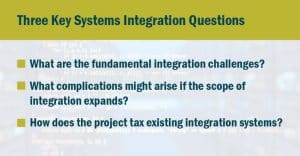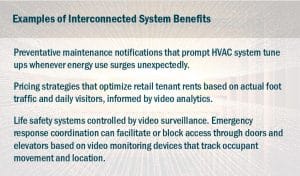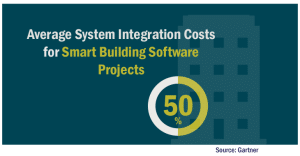Master Systems Integrators Unlock Advanced Technology Potential
As data becomes the new gold, systems that optimize and integrate technology solutions are taking on greater importance.
Performance analytics from interconnected technologies now dictate financial, operational and security decisions at critical facilities, institutional buildings, and commercial properties around the world. Yet, too often, system integration considerations are left toward the end of system design or overlooked entirely. As a result, individual systems are implemented disparately, and the benefits go unclaimed.
To ensure technology system benefits are realized early in the planning stages, a Master Systems Integrator (MSI) can, if scoped correctly, develop a holistic, strategic approach. Consequently, engaging an MSI early in planning and design phases has emerged as a solution to tackle the complexity of technology integration.
Collaborative Systems Integration
Multiple definitions of Master Systems Integrators are used across the technology industry, leaving many facility owners with an unclear understanding of its importance and applicability. Successful system integration starts by knowing the difference among system design, implementation and integration roles.
A design consultant such as Burns Engineering assesses the technology landscape to determine how their client might benefit from new innovations, guiding and educating the client toward the most appropriate technology solution.
Design consultants must understand needs of the organization, collaborating directly with end users to identify their operational challenges, limitations and strategic goals. Additional tasks include implementing streamlined processes that can boost operational efficiency.

“Successful system integration starts by understanding the difference in design roles.”
A system provider implements disparate types of technologies throughout a facility, campus, or other type of construction site. A modern airport renovation, for instance, can often include 40-50 intelligent systems. One provider may specialize in content management systems, utilizing video analytics for airport video surveillance, while another may be limited to visual docking guidance systems. Having separate providers creates the need for integration.
An MSI, at minimum, defines communication protocols between the chosen technology systems. This service relies upon a thorough understanding across a wide range of software solutions. An effective MSI creates communication pathways, develops integration protocols, and facilitates the process for all parties to develop an early and more-accurate estimate of project costs. An MSI can even identify and oversee the selection and implementation of third-party, proprietary integration software.

An especially robust MSI approach involves the MSI themselves designing unique software and custom dashboards. Each project can benefit from clearly displaying how disparate applications communicate with each other, how individual systems are performing, and what system adjustments would result in further improvements.
MSIs can develop trust by playing a role in setting standards and expectations for a custom integration, assisting the user to procure a prescriptive interface ideally matched to their unique needs. In this scenario, the design consultant would develop the scope of owner or stakeholder requirements and possibly manage the software procurement process, while the MSI would develop system-specific requirements.
New Data Offers New Opportunities
Advanced technology systems offer a torrent of information. Integration is essential to ensure the data is actionable, intuitive, shared collaboratively with the right decision makers, and delivered at the right time.
Recent technology amenities include, for example, Smart Building Management Systems (BMS) that control and monitor a wide range of interconnected infrastructure. Within a single dashboard, these technologies can track and adjust heating, ventilation and air conditioning (HVAC) settings, lighting systems, various security measures, and more.
On an equipment level, an estimated 50 billion devices, appliances and other “Internet of Things” (IoT) can now be connected online, providing facility operators with insights into an increasing number of consequential facility decisions.
The combination of BMS applications, machine-learning solutions, and IoT devices can result in optimized occupant comfort and safety, real-time emergency response, reduced energy consumption, faster and more accurate decision making, and additional revenue-generating opportunities. Benefits can be further multiplied as each system communicates with the next.
Content management systems and visual docking guidance systems may, for example, function well enough alone. By integrating video surveillance with other systems, however, innumerable advantages are created. Think of the possibilities from a centralized dashboard that uses video displays to monitor all physical access control, fire alarm, and emergency management systems. Integrations also allow system operators to offer personalized, location-based services.

External Expertise for Internal Integrations
Due to the sheer volume of devices, integration can become overwhelming, especially for organizations which may not be accustomed to smart building design. Built-in integration capabilities of smart IT and OT platforms often, unfortunately, fall short. Software providers generally lack motivation to ensure their systems adequately communicate with other products on the market.
In response, facility and IT managers are told to find a solution, leading integration to become one of their top three technical challenges.
A do-it-yourself approach may be hailed as cost-effective. But relying on internal staff frequently results in higher costs and lesser functionality. Internal teams may not anticipate changes in project scope — especially as new uses of the technology are discovered — or may not be aware of emerging best practices. Adding new integrations at the end of a project can involve costly reconfiguration of the entire system.

A wide range of integration providers now exists. These include automation service providers who have begun offering their own system-integration services. While these companies are experts in lighting, HVAC, elevators or security cameras, for instance, their knowledge may be limited to their respective fields.
An effective MSI, on the other hand, can install and, in some instances, design any hardware, software, network and specialized technology solution. This is accomplished by the MSI developing the solution themselves or with the assistance of a subcontracted team. Some offer “off-the-shelf” solutions. Others build an approach customized to the long-term needs of each client.
Some MSIs assume responsibility for on-going maintenance and service. If the MSI owns the integration solution, users should consider the disadvantage of being locked into a long-term agreement.
If successfully designed, the benefits of smart building technologies are limited only by the needs and imagination of its users.
Building Data Architects
From a vantage point overseeing the entire technology-system ecosystem, a design consultant teamed with an MSI can identify IT and OT integration challenges early in the design phase.
Understanding the data-tracking needs of each technology solution is essential. Doing so ensures sensors, communication infrastructure, and other supporting systems are properly incorporated into project design.
For instance, a video surveillance system may be designed for a minimum frames per second (FPS) requirement. Integrating the video platform with additional systems, however, may reveal a higher frame rate is required, leading to increased requirements of bandwidth, structured cabling, and content management.
Likewise, postponing integration can cause projects to be ensnared by management procedures and last-minute surprises. System integrations often involve considerations related to stakeholder acceptance, data ownership, and use of proprietary technologies. If left toward the back end, project managers may find such considerations too much of a hurdle, making integration nearly impossible.
By adding an MSI to an advanced-technology design team from the start, facility owners can unlock the full operational benefits of emerging technologies and, in the process, create more productive, profitable and sustainable facilities.


